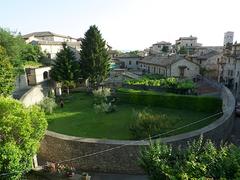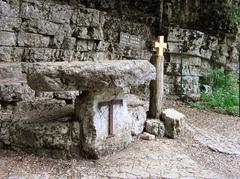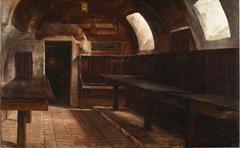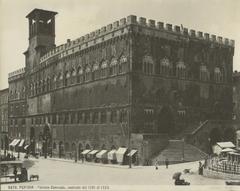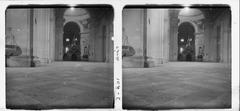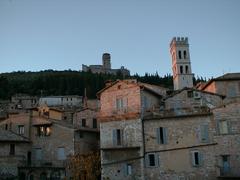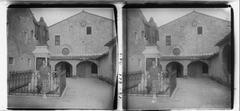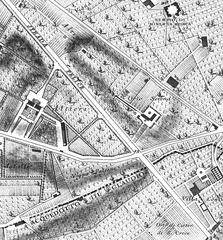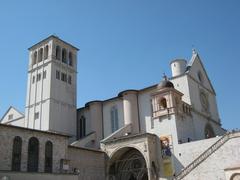
Visiting the Assisium Amphitheatre in Assisi, Italy: Tickets, Hours, and Tips
Date: 14/06/2025
Introduction
Nestled in the historic heart of Assisi, the Assisium Amphitheatre stands as a compelling relic of the town’s Roman roots. Built in the 1st century AD, this amphitheatre is not only a testament to ancient engineering but also an enduring feature of Assisi’s urban landscape. Though much of the original structure has been lost or integrated into later medieval developments, its distinctive elliptical footprint remains visible, woven into the very fabric of the town. This comprehensive guide explores the amphitheatre’s history, architectural features, cultural significance, and provides up-to-date visitor information—including hours, ticketing, accessibility, and recommendations for nearby attractions. Whether you are passionate about archaeology, fascinated by Italian history, or simply eager to discover Assisi’s hidden treasures, the Assisium Amphitheatre offers a unique window into the evolution of urban life in Umbria (Italy Beyond the Obvious; Lucadea).
Table of Contents
- Introduction
- Origins and Construction
- Role and Significance in Roman Assisi
- Medieval Transformation and Urban Integration
- Archaeological Discoveries and Current Remains
- Layout and Architectural Features
- Visiting Today: Hours, Tickets, and Accessibility
- Practical Tips and Visitor Experience
- Frequently Asked Questions (FAQ)
- Nearby Attractions and Suggested Itineraries
- Preservation, Legacy, and Visitor Recommendations
- References
Origins and Construction
The Roman amphitheatre of Assisi was constructed in the 1st century AD, a period marked by the expansion of Roman urbanism in Umbria. Assisi, then known as Asisium, had become a Roman municipium by the 1st century BC, and the construction of a monumental amphitheatre signaled its prosperity and importance (The Rook and Queen; The Wildlife Diaries). Built primarily from locally quarried limestone, the amphitheatre followed the typical Roman elliptical plan, enabling optimal sightlines and crowd movement. While the precise dimensions are debated, estimates suggest the structure could accommodate several thousand spectators, providing a stage for gladiatorial contests, animal hunts, and civic gatherings (Italy Beyond the Obvious).
Role and Significance in Roman Assisi
The amphitheatre was central to civic life in Roman Assisi, symbolizing the town’s integration into the Roman world. Like other Roman amphitheatres, it served as a venue for entertainment, reinforcing social cohesion and imperial authority. Its construction affirmed Assisi’s status as a significant Roman settlement, with the resources and prestige to build such monumental architecture (Ancient World Magazine). The amphitheatre’s position—just outside the ancient city walls—was characteristic of Roman town planning, providing easy access while minimizing disruptions to daily life (The Wildlife Diaries).
Medieval Transformation and Urban Integration
After the fall of the Roman Empire and the devastation of Assisi by the Ostrogoths in 545 AD, the amphitheatre fell into disuse. During the Middle Ages, its stones were quarried for new buildings, and its outline became the foundation for a medieval residential quarter. Today, the amphitheatre’s elliptical footprint is still visible in the street plan of the area known as Via Anfiteatro Romano, where houses and gardens trace the ancient arena’s perimeter (Italy Beyond the Obvious). This layering of history is a hallmark of Assisi, where Roman, medieval, and modern elements coexist.
Archaeological Discoveries and Current Remains
Although little of the amphitheatre’s superstructure survives above ground, archaeological excavations have uncovered significant substructures. The development of the Nun Spa Museum revealed pillars, staircases, podiums, ritual pools, and vaulted cisterns—providing insight into the amphitheatre’s original grandeur and sophisticated engineering (Italy Beyond the Obvious). Much of what remains is now incorporated into private buildings or can be seen within the Nun Spa Museum, which artfully blends ancient ruins with modern amenities.
Layout and Architectural Features
Elliptical Plan and Dimensions
The amphitheatre’s elliptical plan allowed for efficient crowd movement and optimal visibility. Although smaller than the Colosseum, its scale was impressive for a provincial town, reflecting Assisium’s regional significance. The cavea (seating) was arranged in concentric tiers, divided by stairways and passageways (vomitoria), and constructed from local limestone (Lucadea). Remnants of the cavea and the protective podium wall can still be discerned in garden walls and medieval structures.
Arena and Substructures
At the heart of the amphitheatre, the arena once hosted gladiatorial games and public spectacles. Archaeological evidence reveals underground corridors (hypogeum) used for logistical support and dramatic effects. The main entrance arch, built of travertine, remains a prominent feature (Lucadea).
Materials and Construction
The use of local Umbrian stone and recycled masonry from earlier structures demonstrates Roman builders’ resourcefulness. Roman concrete foundations may have supported the original seating and vaults, and vestiges of these elements are visible today (assisionline.com).
Visiting Today: Hours, Tickets, and Accessibility
Visiting Hours and Tickets
The Assisium Amphitheatre is an open-air site integrated within a residential area, accessible to the public free of charge, 24 hours a day year-round (Italy Heaven). There are no formal opening or closing times, and no ticket is required to walk the streets outlining the ancient arena. However, access to certain archaeological remains within the Nun Spa Museum may be subject to museum hours (typically 10:00 AM to 6:00 PM) and a modest entrance fee (around €8 for adults, with discounts for students and seniors).
Accessibility
The site is best explored on foot, accessible via steep, cobbled streets. While most visitors can enjoy the exterior features, those with mobility challenges may find the terrain difficult. The Nun Spa Museum and some nearby areas offer partial accessibility; it’s advisable to check in advance for specific accommodations.
How to Get There
From the Piazza del Comune, follow signs to Via Anfiteatro Romano or use a walking map (Nomads Travel Guide). Public transport connects Assisi to regional hubs, and the site is less than a 10-minute walk from central landmarks.
Practical Tips and Visitor Experience
- Best Time to Visit: Early morning or late afternoon for ideal lighting and fewer crowds.
- Footwear: Wear comfortable shoes suitable for cobbled and uneven terrain.
- Photography: The curved street, entrance arch, and blend of Roman and medieval architecture provide excellent photo opportunities. Please respect private property.
- Facilities: No restrooms or visitor centers at the amphitheatre; amenities are available in the town center.
- Guided Tours: Some local operators and walking tours include the amphitheatre, often combined with other Roman and medieval sites (Go Ask a Local).
Frequently Asked Questions (FAQ)
Q: What are the visiting hours of the Assisium Amphitheatre?
A: The site is open 24/7 as a public area. The Nun Spa Museum (with some amphitheatre remains) is generally open 10:00 AM–6:00 PM; check for seasonal variations.
Q: Is there an entrance fee?
A: No fee is required to walk around the amphitheatre’s exterior. Museum access requires a ticket.
Q: Is the site wheelchair accessible?
A: Accessibility is limited due to steep, uneven streets.
Q: Can I join a guided tour?
A: Yes, some walking tours and museum visits include the amphitheatre.
Q: Are there other Roman sites nearby?
A: Yes. The Temple of Minerva, Roman Forum, and city gates are all within easy walking distance.
Nearby Attractions and Suggested Itineraries
- Temple of Minerva: A remarkably preserved Roman temple in Piazza del Comune.
- Roman Forum: Archaeological remains beneath the piazza.
- Rocca Maggiore: Medieval fortress with panoramic views (Maddy’s Avenue).
- Via San Rufino: Leads to the Cathedral of San Rufino and highlights Roman and medieval architecture.
- Monte Subasio Park: For nature walks and scenic overlooks.
Suggested route: Start at Piazza del Comune, visit the amphitheatre via Via Anfiteatro Romano, continue to Rocca Maggiore, and loop back through the historic center.
Preservation, Legacy, and Visitor Recommendations
The Assisium Amphitheatre is a living testament to Assisi’s capacity for adaptation and continuity. Its elliptical outline, preserved in the street plan and building foundations, reveals the ingenuity of Roman urbanism and the town’s layered history. While its remains are understated compared to Italy’s grandest amphitheatres, the site rewards careful observation and reflection. Visitors are encouraged to combine their visit with other Roman and medieval sites, participate in guided tours, and use resources like the Nun Spa Museum and the Audiala app for deeper insight (Italy Beyond the Obvious; Lucadea).
References
- Italy Beyond the Obvious – Visiting the Assisium Amphitheatre in Assisi: History, Tickets, and Travel Tips
- Lucadea – Visiting the Roman Amphitheatre of Assisi: Hours, Tickets, History, and Tips
- The Rook and Queen – A Comprehensive Guide to Visiting the Assisium Amphitheatre in Assisi
- Italy Heaven – Exploring the Assisium Amphitheatre: Visiting Hours, Tickets, and Historical Significance
- Nomads Travel Guide – Assisium Amphitheatre Visiting Hours, Tickets & Guide to Assisi Historical Sites
- Maddy’s Avenue – Assisium Amphitheatre Visiting Hours, Tickets & Guide to Assisi Historical Sites
External Links
- Nun Spa Museum Official Site
- Montesubasio: Roman Domus, Forum, and Amphitheatre
- Go Ask a Local – Travel Guide to Assisi
- Wikipedia: Assisi
Visual Resources
Alt tag: Assisi amphitheatre visiting hours and ticket information displayed with ruins in background. Alt text: Entrance arch of the Assisium Amphitheatre, a key Assisi historical site. Alt text: Map highlighting Assisium Amphitheatre’s location relative to Assisi historical sites.
Internal Links
Call to Action
Download the Audiala app for exclusive content, guided tours, offline maps, and up-to-date visitor information about Assisi’s ancient sites. Follow us on Instagram and Facebook for travel inspiration, historical insights, and the latest updates on special events and conservation efforts.
